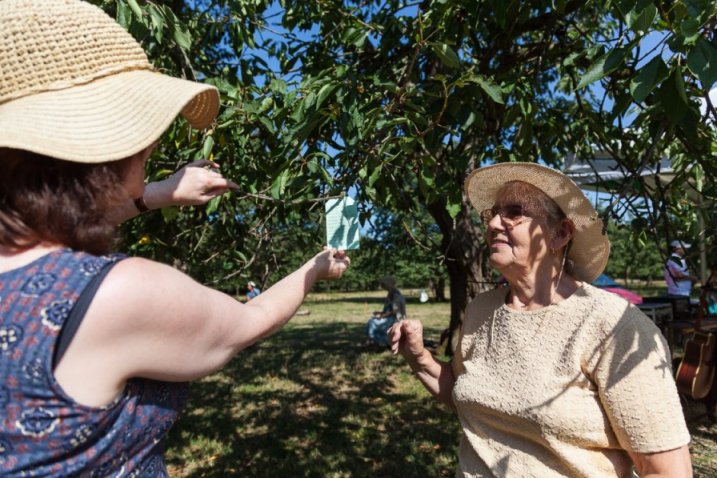
Reaching the huge numbers
Older people want to be part of an intergenerational community not a ‘crinklies camp’. Stephanie Fuller shares this and other tips on how to reach out to older audiences.
Did you know that many organisations categorise older people as anything from 50 years upwards? By that token, that puts me and my 87-year-old mum in the same box, which to me makes very little sense. Older people (like many demographics) also tend to get lumped together as though they all think alike and have the same interests. This is clearly nonsense. Moreover, much of the arts-based work for older people is focused on older people in care homes, which represents only 5% of the population over retirement age. The value of what this kind of activity can bring to people’s lives goes without saying, but there are huge numbers of other older people out there not living in care homes who might welcome new opportunities and who have time (if not necessarily large amounts of income) to devote to it.
This is potentially a huge market and arts organisations are missing a trick if they fail to engage with it
Like many arts organisations, Ideas Test is based in an area (Swale and Medway in Kent) with a substantial older population, and one that’s predicted to grow significantly over the next decades. As one of the 21 Creative People and Places projects around the country, charged with increasing sustainable opportunities for arts engagement, it made obvious sense for us to make sure we were connecting with this demographic and offering them activities which they found attractive and interesting.
The two largest groups for us profiled by the Audience Agency’s Audience Spectrum, Dormitory Dependables (22%) and Up Our Street (13%), have some propensity to engage with the arts, but based on the overall statistics in Swale and Medway many of them clearly weren’t doing so. The former group are regular but not frequent attenders, and the latter often not engaging because of practical barriers.
Our approach is always to start by talking to local people about what they’re interested in and what they think. So we work with a network of ‘community catalysts’, nominated by local residents, to generate new projects, allocate funding, and make connections. This works very well. In our recent audience survey 91% of people who came to one of our events said it had inspired them to seek out more arts activity. We believe that people need agency in the cultural activities they want to take part in, rather than just being offered something that may or may not be appropriate. Our research has also identified barriers and attractors for potential participants. At all ages poor transport infrastructure is an issue, and for older people who may not have any alternative this can be prohibitive. People are also keen to take part within their community, and are more likely to hear about things by word of mouth and attend if invited by someone they know.
A good example of this is the rural touring model, where high-quality work comes to village halls, libraries and community centres, and the audience is generated by local volunteer promoters. Our Now Showing scheme, a partnership with Applause Rural Touring that supports new promoters and helps them to present work locally, has proved successful because it solves all of these issues.
We also launched Third Age Creatives as a way of encouraging older people to apply for small commissions and generate their own projects. These range from an older people’s community group working with African singers and musicians to expand their musical repertoire, to a local band with older members who wanted to work with younger people to develop new material and attract new participants. This desire not to be ghettoised into an old people’s group is one which has been voiced by many of the people we have talked to. They want to be part of an intergenerational community, rather than in the ‘crinklies camp’. We are also interested in older people as artists. There are many still practising but not necessarily getting the opportunities or attention received by younger practitioners.
It takes time to build relationships and confidence. For example, a project called ‘Neighbours’ at the almshouses in Faversham, led by artist Siobhan Timoney, supported a group of residents to try out visual arts activity and writing. Many of them went from saying they couldn’t do anything to becoming enthusiastic participants, and working together on an exhibition. Mary, one of the women involved, went along to see ‘Cracking the Crinoline’, performed by Moving Memories, a dance company of older women at an Ideas Test festival. She was so inspired that she decided to do some contemporary dance as a group activity. ‘Late Starters’ was the result and by working with choreographer Sian Stevens, Mary and her peers are developing their own work.
So what have we learned? Older people are very keen to see work in a social setting, many welcome the opportunity to learn new skills, or re-engage with things they used to do, sometimes not since they were at school, such as playing a musical instrument. Sometimes a tailored opportunity is useful. For example, filmmaking using mobile phones or tablets is a familiar activity to many young people, but much less so for many older people.
The benefits of remaining physically and mentally active and socially engaged for health and wellbeing in later life are well evidenced. Our experience suggests that, given the chance, older people will vote with their feet and get involved with activities that are accessible to them. This is potentially a huge market and arts organisations are missing a trick if they fail to engage with it.
Stephanie Fuller is Director of Ideas Test.
www.ideastest.co.uk
Tw @steph_fuller
Tw @ideastest

Join the Discussion
You must be logged in to post a comment.